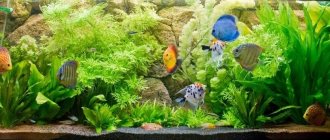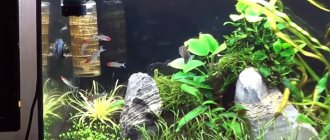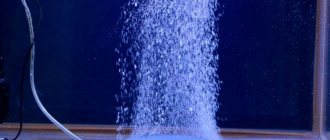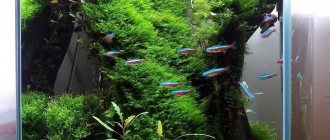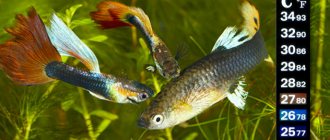Home/AQUARIUM CONSTRUCTION/Decorative stones for an aquarium - selection, preparation
Stones in an aquarium are used not only as an interesting decoration, but also as an object necessary for the life of aquatic animals. But at the same time, they can lead to serious illnesses in fish and even death. This happens when the stones are not selected correctly and are not processed before entering the aquarium. Therefore, it is worth understanding what decorative decorations can be used and how to choose them correctly.
What stones can be used
Decorative stones for an aquarium can be:
- natural processed;
- marine;
- alive;
- artificial.
Natural processed stones
Sold in pet stores and prepared for use in an aquarium environment. Often stores sell ready-made compositions made of natural rocks: caves, grottoes, houses, mountains.
Treated stones are highly durable. They are safe for aquarium inhabitants.
Each natural pebble has its own effect on water quality, so when choosing stones for an aquarium, you need to take this effect into account.
Neutral aquarium stones that do not have any effect on the water:
- granite in an aquarium: the rock is of volcanic origin, does not produce any substances that affect the quality of water, granite makes beautiful decor due to its different shades;
- gneiss: slate of a uniform shade with multi-colored inclusions: pink, black, green, white;
- sandstone in the aquarium: sedimentary rock - a mixture of sand with clay or crushed stone, looks beautiful thanks to its different bright shades.
Rocks that increase water hardness:
- shale: hard rock of a layered type, pure shale does not affect water quality, but specimens with veins or cracks change water quality;
- tuff: a porous rock of volcanic origin, they have beautiful colors and an unusual porous structure, but it must be used with caution, the water becomes hard;
- shell rock: this is a rock consisting of small shells of mollusks, which have become fossilized over time and created a single composition; the unusual appearance attracts aquarists;
- limestone: sedimentary rock consisting of calcium and magnesium salts, common colors: yellow, white, gray, before use, you need to keep the pebble in water for 2-3 days;
- marble: crystallized limestone and dolomite, therefore affecting the hardness of water, a beautiful pebble decorates the tank, it has an unusual pattern of small multi-colored veins.
Often sea pebbles or gravel are placed in aquarium tanks. These are natural pebbles with rounded edges. Sea pebbles are safe for fish and do not affect water quality. Sea pebbles for an aquarium attract with a variety of shapes, sizes, and the ability to create any decor.
You can diversify the design with lava. These are volcanic rocks of unusual shape that do not affect water quality. Neutral lava weighs little, and unusual shapes make it possible to show imagination when decorating, returning to the Neolithic era. Color: dark brown to black. Advantages of lava: lightness, neutrality. The downside is the high price.
Sea stones
Many aquarists love marine breeds because they are beautiful, unusually shaped and as natural as possible. You cannot take untreated sea stones. Before use, they must be boiled to neutralize the effect on the aquatic environment. Additionally, each pebble is treated with a stiff brush, removing all dirt and remaining salt.
Living stones
Living pebbles or parts of coral stand out when decorating. They are collected from the sea, processed and sent to pet stores. Corals look very beautiful, which is why they attract aquarists. Corals belong to the marine ecosystem, so it is recommended to place them in water with marine fish.
Corals are expensive stones, but they are completely safe for marine life and recreate the natural environment. They contain plankton, which fish feed on. They contain many other nutrients for marine life. Corals filter, purify, and enrich the water with oxygen.
Pros of living corals:
- as safe as possible for fish;
- high level of filtration;
- contain nutrients and plankton;
- decorate the aquarium;
- serve as shelter for small fish.
Corals breathe, grow, develop. If you want to make your aquarium with rocks unique, buy some corals. They significantly transform the aquatic world, creating a sustainable eco-environment.
Artificial Aquarium Rocks
Artificial stones do not affect the quality of water, they do not benefit the inhabitants of the aquarium. The purpose of artificial stones is to make the design of the tank more interesting. The stones are made from harmless plastic. Externally, artificial stones can imitate natural rocks.
Aquarists love artificial decor for its wide selection of shapes, colors, and sculptures. The advantage of artificial stones is their low price.
Suitable Types
It may seem that the choice is very limited, but in nature there are many breeds that are completely safe for aquarium fish and plants. These breeds can be easily found almost anywhere on the planet. What stones can be used for an aquarium:
- granite;
- frozen magma;
- petrified wood;
- quartz;
- slate;
- slate.
Among these breeds, there is a tendency to increase pH and water hardness. But it is normal and often minor.
How to choose stones for aquarium design
Pebbles for design are selected according to the type of fish. Before purchasing stones for design, you must decide which fish will live in your aquarium. Some people need soft water, others highly alkaline, and others need hard water.
Basic rules for choosing pebbles:
- they should not affect water quality;
- the structure must be dense so that the pebbles do not crumble or fall off;
- there should be no foreign inclusions, spots, or corrosion on the stones;
- You can’t buy heavy rocks for a small tank and small fish;
- You should not place different rocks in one tank.
It is allowed to place evenly colored pebbles with veins and inclusions of natural origin in an aquarium with fish. Pebbles can be collected from quarries, reservoirs, and construction sites.
UDeco River Amber "Amber gravel"
Leader in consumer demand Country: Russia Average price: 300 rub. Rating (2019): 4.7
The “Amber Sand” line is represented by a wide range of sizes of fractions included in the packages – from 0.1 mm to 5 mm. Our review includes the most popular variety, which includes particles from 2 to 5 mm. The rounded material does not change the overall and carbonate hardness, so it is appropriate to use it in universal structures. It is characterized by a natural sand color and light transparency. Both plants and fauna feel equally comfortable in it, especially if volcanic lava of the same brand is additionally used as a substrate. “Amber gravel” can also be laid in paludariums or terrariums.
Preparing the Stones
Before placing a stone in the aquarium, you need to check its compatibility with water. Before checking, the pebble is thoroughly cleaned with a stiff brush, removing dirt, salts, and impurities. The rock is then tested with vinegar. It is necessary to drop acetic acid onto a pebble and monitor the reaction. If foam, bubbles or hissing occurs, the stone will not work. The unsuitability of the stone is also manifested in the appearance of green or red spots after exposure to acid.
After inspection, the rock is washed again without chemicals or soap. It is enough to clean the stone with a stiff brush under running water. The brush will remove any impurities, and the water will wash away microorganisms. It is recommended to boil the pebbles for half an hour. Cold pebbles are placed in the tank with the fish.
Pebbles for aquarium design are a beautiful and stylish decor. You can use flat pebbles to lay out unusual compositions or place bright round cobblestones at the bottom. When choosing pebbles, make sure they are safe for aquatic life. Follow all guidelines before placing rocks in your aquarium. The main thing is the safety of all your pets.
Harmful breeds
Experienced aquarists do not recommend using carbonates. They can increase water hardness and pH, thereby affecting the overall health of the fish tank. Although they are not harmful in all cases, it can be difficult for a beginner to determine the possible risks. Most often among carbonate rocks you can find:
- alabaster;
- coral;
- crushed shells;
- dolomite;
- limestone;
- many types of sandstone;
- marble.
The easiest way to test the rock's safety is to apply a few drops of white vinegar to the surface. If the liquid begins to fizz and bubble, the rock most likely contains carbonate. You can replace vinegar with hydrochloric acid to improve the accuracy of the test.
Black
Taking into account the decorative function of the substrate, the aquarium is designed to emphasize the beauty of the aquatic “garden” and the fish living in it. As practice shows, black in the “home” for fish looks very advantageous, since due to its color, contrasting fish look very bright. Any dirt will be more visible on a white background than on a black or dark gray background. Black aquarium soil can be natural (black quartz, granite chips) or painted (almost any type, but you need to choose those brands whose product does not fade).
When choosing black flooring, pay attention to German-made products:
- Dennerle Crystal Quartz.
- Price in Moscow is 979-1260 rubles per 4.92 kg.
- The filler is black, the granules are well rounded, safe for representatives of the aquatic world. The flooring is perfect for good vegetation development. Fraction 0.7-1.2 mm. Bottom flooring for nano-aquariums. Manufacturer – Germany.
- Pros:
- CO2 resistance;
- Rounded particles;
- Natural color;
- Neutral to water, does not change hardness;
- Promotes the development of the root system of plants.
- Cons: none found.
Cheaper options:
- Hydor H2SHOW.
- Price 432 rub. for 5 kg.
- High-quality painting, natural quartz. Well rounded, safe and convenient for the inhabitants of the home pond. Designed to be used together with other decorations in the Water World concept, but can also be safely used separately.
- Pros:
- Does not emit harmful substances, does not shed;
- Neutral, suitable for all bodies of water.
- Cons: none found.
The best soils for aquariums with abundant flora
This product category includes all kinds of nutritional mixtures and substrates. Their presence in the aquarium eliminates the need to use additional fertilizers. Such soils are suitable for all representatives of the flora. The mixture is added to the soil at the time of establishing a new aquarium, and is also used to improve the composition of old tanks.
The product ensures active, healthy growth of plants, promotes rapid rooting of the inhabitants of the tank, and transports nutrients to their root system. The described soil mixtures guarantee not only excellent water circulation, but also greater water permeability compared to traditional gravel. Two mixtures emerged as the best soils for aquariums with a large number of “green” inhabitants.
Nutrient mixture Power Sand Special M (ADA) - the best option for a Dutch or nano aquarium
The product has proven itself as a nutrient substrate for aquariums. The soil contains peat, mineral fertilizers, porous elements and beneficial microorganisms.
The use of the mixture guarantees high-quality biological cleaning of the aquarium. In addition, the nutrient substrate plays the role of a growth stimulator for representatives of the flora living in the tank. The shelf life of the soil is quite long. The product is also indicated for use in shrimp tanks, since Power Sand Special M (ADA) is also a decent food source for these organisms.
Let us note the main positive aspects of the mixture:
- providing a good nutritional basis for beneficial bacteria;
- guarantee of excellent circulation in the aquarium;
- stimulation of plant growth and development;
- providing favorable conditions for the reproduction of flora representatives;
- Possibility of use in shrimp tanks.
As a disadvantage of this brand of soil:
- the cost is somewhat overpriced in comparison with similar products.
The general opinion of customers about the nutritional formula is positive. Many consumers are ready to purchase expensive soil for its obvious quality characteristics.
Deponit (substrate) DeponitMix (Dennerle) – the best mixture for stimulating plant growth
We are talking about soil containing a huge amount of active substances of mineral and organic origin. Such a nutritious substrate will become an indispensable stimulator of plant growth. Typically, a similar product is used in combination with neutral soils. The mixture contains fast-acting substances in the form of granules, as well as long-acting impurities. In addition to those mentioned, Deponit contains porous elements and living beneficial microorganisms.
The product must be accompanied by instructions for its use, which specify the dosage and procedure for using the primer. Often, in the case of Deponit, it becomes necessary to use a thermal cable to improve water circulation in the tank.
Let us highlight a number of main advantages of the product:
- ensuring the biological activity of beneficial microorganisms;
- stimulation of growth of flora representatives;
- “inhibition” of the process of growth and development of algae in the aquarium.
The disadvantages of the mixture were:
- can be used exclusively in combination with neutral types of soil;
- the possibility of acidification of the lower levels of the soil.
Most buyers liked the soil. Users consider the product an excellent example of the optimal balance between price and quality.
UDeco River Amber "Amber gravel"
The “Amber Sand” line is represented by a wide range of sizes of fractions included in the packages – from 0.1 mm to 5 mm. Our review involves the most common variety, which includes particles from 2 to 5 mm. The rounded material does not change the overall and carbonate hardness, making it suitable for use in multifunctional structures. It is distinguished by its true sand color and light transmittance. Both plants and fauna feel equally comfortable in it, especially if volcanic lava of the same brand is additionally used as a substrate. “Amber gravel” can also be placed in paludariums or terrariums.
